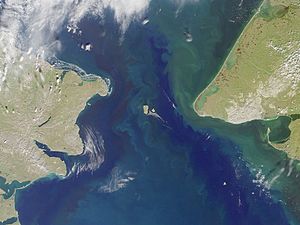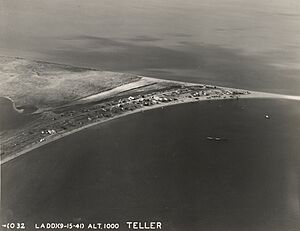Teller, Alaska facts for kids
Quick facts for kids
Teller
Tala / Iġaluŋniaġvik (Inupiaq)
|
|
|---|---|

Teller Townsite July 2023
|
|
| Country | United States |
| State | Alaska |
| Census area | Nome |
| Incorporated | October 10, 1963 |
| Area | |
| • Total | 1.68 sq mi (4.35 km2) |
| • Land | 1.49 sq mi (3.87 km2) |
| • Water | 0.19 sq mi (0.49 km2) |
| Elevation | 0 ft (0 m) |
| Population
(2020)
|
|
| • Total | 249 |
| • Density | 166.89/sq mi (64.42/km2) |
| Time zone | UTC-9 (Alaska (AKST)) |
| • Summer (DST) | UTC-8 (AKDT) |
| ZIP code |
99778
|
| Area code | 907 |
| FIPS code | 02-75930 |
| GNIS feature ID | 1410730 |
Teller (Inupiaq: Tala or Iġaluŋniaġvik) is a small city in Alaska, United States. It is located in the Nome Census Area, Alaska. In 2010, about 229 people lived there. By 2020, the population had grown slightly to 249.
Teller is built on a narrow strip of land called a spit. This spit, known as Nuuk in the Iñupiaq language, separates Port Clarence Bay and Grantley Harbor. It is also near the outlet of the Imuruk Basin.
Contents
History of Teller
Early Inupiat Settlements
The Iñupiat had a fishing camp called Nuuk about 32 kilometers (20 miles) south of Teller in the early 1800s. An expedition led by Frederick William Beechey visited the area in 1827. They found three camps with about 400 people living there. They also found a winter camp and burial sites near where Teller is today.
Western Union and Reindeer Herding
In 1866 and 1867, a group from the Western Union telegraph company spent the winter at the current site of Teller. They called it Libbyville or Libby Station.
Later, the United States Government started a program to introduce reindeer herding in Alaska. The Teller Reindeer Station operated near Teller from 1892 to 1900. Experienced Sami reindeer herders and their families came from Norway to teach the Iñupiat how to herd reindeer. The station was named in 1892 after Henry Moore Teller, a U.S. Senator.
Gold Rush and Growth
Teller was officially started in 1900. This happened after gold was discovered at the Bluestone Placer Mine, about 25 kilometers (15 miles) south. The new settlement took its name from the reindeer herding station.
During the early 1900s, Teller was a very busy place. Its population grew to about 5,000 people. It became an important trading center for the region. People from nearby places like Diomede, Wales, Mary's Igloo, and King Island came to Teller to trade goods.
Missions and Modern Life
In 1900, the Norwegian Evangelical Lutheran Church built the Teller Mission. It was located across the harbor from Teller. In 1903, the mission was renamed Brevig Mission. This was in honor of Reverend T.L. Brevig, who also served as Teller's first postmaster.
In 1926, the airship Norge made a stop in Teller. This was during its first flight over the North Pole, traveling from Norway to Nome. Many people who live in Teller today originally came from Mary's Igloo. Mary's Igloo is now a summer fishing camp and no longer has people living there all year.
Today, Teller is an Iñupiat village. Its residents mostly rely on hunting and fishing for their food and way of life.
Geography and Climate

Where is Teller Located?
Teller is located on a spit, a narrow piece of land, about 116 kilometers (72 miles) northwest of Nome. It is found on the Seward Peninsula in Alaska.
The city covers a total area of about 4.35 square kilometers (1.68 square miles). Most of this area, about 3.87 square kilometers (1.49 square miles), is land. The rest, about 0.49 square kilometers (0.19 square miles), is water.
What is Teller's Climate Like?
Teller has a very cold climate. It is known as a continental subarctic climate. This means it has long, very cold winters and short, cool summers. The climate is almost a tundra climate, which is even colder and has permafrost.
| Climate data for Teller | |||||||||||||
|---|---|---|---|---|---|---|---|---|---|---|---|---|---|
| Month | Jan | Feb | Mar | Apr | May | Jun | Jul | Aug | Sep | Oct | Nov | Dec | Year |
| Record high °F | 47 | 39 | 45 | 48 | 62 | 82 | 79 | 76 | 61 | 53 | 41 | 36 | 82 |
| Mean maximum °F | 33.8 | 32.5 | 33.4 | 40.8 | 53.1 | 68.7 | 70.4 | 68.1 | 56.3 | 46.3 | 37.3 | 30.8 | 72.5 |
| Mean daily maximum °F | 10.2 | 5.7 | 10.3 | 24.0 | 40.9 | 52.1 | 57.5 | 56.0 | 47.3 | 33.0 | 21.2 | 6.9 | 30.4 |
| Daily mean °F | 2.6 | −1.0 | 1.7 | 14.4 | 33.5 | 44.9 | 51.3 | 50.5 | 42.0 | 29.0 | 17.8 | 0.7 | 23.9 |
| Mean daily minimum °F | −4.4 | −8.0 | −6.9 | 5.2 | 26.2 | 37.9 | 45.1 | 44.9 | 36.9 | 24.6 | 12.6 | −5.2 | 17.4 |
| Mean minimum °F | −28.6 | −28.9 | −28.0 | −11.1 | 7.6 | 27.0 | 36.7 | 36.3 | 27.2 | 11.4 | −9.6 | −22.6 | −31.5 |
| Record low °F | −38 | −45 | −40 | −32 | −17 | 12 | 25 | 27 | 20 | −10 | −30 | −36 | −45 |
| Average precipitation inches | 0.80 | 0.73 | 0.83 | 0.41 | 0.33 | 0.47 | 0.92 | 2.42 | 1.08 | 0.60 | 0.64 | 0.49 | 9.73 |
| Average snowfall inches | 6.9 | 7.1 | 11.1 | 4.6 | 1.8 | 0.1 | 0.0 | 0.0 | 0.3 | 1.5 | 6.6 | 6.1 | 46.2 |
| Record high °C | 8 | 4 | 7 | 9 | 17 | 28 | 26 | 24 | 16 | 12 | 5 | 2 | 28 |
| Mean daily maximum °C | −12.1 | −14.6 | −12.1 | −4.4 | 4.9 | 11.2 | 14.2 | 13.3 | 8.5 | 0.6 | −6.0 | −13.9 | −0.9 |
| Daily mean °C | −16.3 | −18.3 | −16.8 | −9.8 | 0.8 | 7.2 | 10.7 | 10.3 | 5.6 | −1.7 | −7.9 | −17.4 | −4.5 |
| Mean daily minimum °C | −20.2 | −22.2 | −21.6 | −14.9 | −3.2 | 3.3 | 7.3 | 7.2 | 2.7 | −4.1 | −10.8 | −20.7 | −8.1 |
| Record low °C | −39 | −43 | −40 | −36 | −27 | −11 | −4 | −3 | −7 | −23 | −34 | −38 | −43 |
| Average precipitation mm | 20 | 19 | 21 | 10 | 8.4 | 12 | 23 | 61 | 27 | 15 | 16 | 12 | 247 |
| Average snowfall cm | 18 | 18 | 28 | 12 | 4.6 | 0.25 | 0.0 | 0.0 | 0.76 | 3.8 | 17 | 15 | 117 |
| Average precipitation days | 5 | 5 | 4 | 4 | 3 | 5 | 8 | 13 | 9 | 6 | 8 | 6 | 76 |
| Source: WRCC | |||||||||||||
How Climate Change Affects Teller
Teller's main townsite is on a low-lying sand spit. This means it is surrounded by water on three sides. Because of this, Teller is very sensitive to changes in climate.
Over the last 20 years, strong storms have become more frequent and more powerful. These storms cause worse flooding. Teller has had to move its airport and landfill about 6.4 kilometers (4 miles) uphill. This was done to escape severe erosion caused by the storms.
In September 2005, a flood damaged many buildings. This included the school, power plant, clinic, and homes. More storms in 2009 and 2011 destroyed parts of Teller's seawall. They also flooded downtown streets with deep water. This water was contaminated, making it unsafe.
Population and People
| Historical population | |||
|---|---|---|---|
| Census | Pop. | %± | |
| 1910 | 125 | — | |
| 1920 | 80 | −36.0% | |
| 1930 | 76 | −5.0% | |
| 1940 | 118 | 55.3% | |
| 1950 | 160 | 35.6% | |
| 1960 | 217 | 35.6% | |
| 1970 | 220 | 1.4% | |
| 1980 | 212 | −3.6% | |
| 1990 | 151 | −28.8% | |
| 2000 | 268 | 77.5% | |
| 2010 | 229 | −14.6% | |
| 2020 | 249 | 8.7% | |
| U.S. Decennial Census | |||
How Has Teller's Population Changed?
Teller first appeared in the U.S. Census in 1910 as a small village with 125 people. The census mistakenly called it Fuller at first. Since 1920, it has been correctly listed as Teller. The city was officially incorporated, or made into a formal city, in 1963.
In 2000, there were 268 people living in Teller. These people lived in 76 households, with 61 of them being families. The population density was about 140 people per square mile.
Most of the people in Teller are Native American. In 2000, about 92.5% of the population was Native American. About 7.5% were White. A very small number, less than 1%, were of Hispanic or Latino background.
Age and Income in Teller
In 2000, a large part of Teller's population was young. About 41.4% of the people were under 18 years old. The average age in the city was 24 years old.
The average income for a household in Teller was $23,000 per year. For families, the average income was $20,000. About 33.9% of families and 37.7% of all people lived below the poverty line. This included 45% of children under 18.
Education in Teller
Teller is part of the Bering Strait School District. The local school is called James C. Isabell School. It teaches students from Pre-Kindergarten all the way through 12th grade.
Notable Person
- Libby Riddles (born 1956), a famous dog musher and author, is from Teller.
See also
 In Spanish: Teller (Alaska) para niños
In Spanish: Teller (Alaska) para niños




